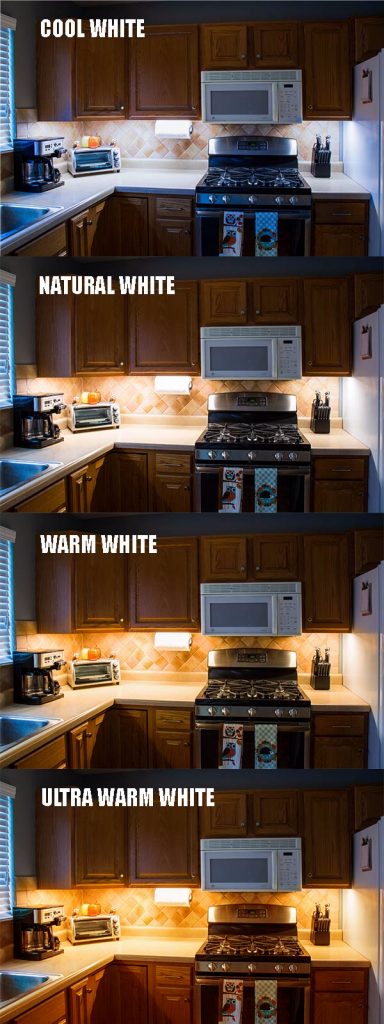To achieve the look you want with LED strip lights, you need to know how bright and what shade of white they are. These two pieces of information are defined by lumens and correlated color temperature (CCT). The first question that most people ask is about brightness.
If you’re shopping for LED lights, you know that the classic method of using wattage to determine brightness is long gone. You’ll have to use lumens. What is a lumen, you ask? It’s a measurement of the amount of light produced by a source. The problem arises when you’re trying to imagine how bright a light will be. Because lumens are a relatively new way to buy lights, you probably aren’t able to pair a number with appearance yet. That’s where this post comes in handy. Check out the photos below to see how certain lumen values translate to LED strip light appearance. In this post and on our site, strip brightness is given in lumens per foot. The photos show an area with 1 foot of natural white strip installed.

Note: If you have an interest in experiencing different light levels, choose a bright strip and use it with a dimmer or controller. Brighter strips will cost more, so if you want one brightness all the time, it might be best to stick with a dimmer strip.
Brightness will also depend on the color temperature you choose. Correlated color temperature (CCT) will tell you what hue and tone of white to expect from a specific light source. CCT is measured in Kelvin (K). Different temperatures on the Kelvin scale represent different colors. For example, light at 2000K-3500K looks more orange/yellow and is called ultra warm or warm white, and as temperature increases in Kelvins, color changes to more of a “paper white” known as natural or neutral white (between 3500K and 5100K) and finally into a bluish white known as cool white (5100K-20000K).

The human eye perceives colors differently even if they are equally as bright as one another. Cool or natural white strips might appear brighter than warm white strips of similar lumen values. Don’t think that picking warm white means your lights will be dim though; they just might not appear asbright as cool white because of the color. All color temperatures are available in different intensities. If you want very bright warm white strips, choose one with a high lumen value.
Keep your personal taste in mind when you’re choosing LED strip lights. Just because one color might appear brighter doesn’t mean you’ll like it. Do you prefer a warm, relaxing environment (warm white strips), or do you like more energetic, crisp surroundings (cool white strips)? Another thing to consider is the color temperature of nearby lights. It will be noticeable if you have cool white under-cabinet strip lights and warm white ceiling lights. If you decide to mix color temperatures and have warm white ceiling lights, you’ll be less aware of the color difference if you choose natural white. Natural white is more neutral and can fit in better with surrounding color temperatures.
Hopefully this post has given you the tools you need to narrow down your LED strip light selection. At the end of the day, it’s your choice. Pick the color and intensity that you think you’ll like best. The images in this post will give you an idea of what to expect. Happy hunting!
led lights,solar lights,led strip lights,outdoor stores,WIFI Deck Lights,WIFI LED Strip